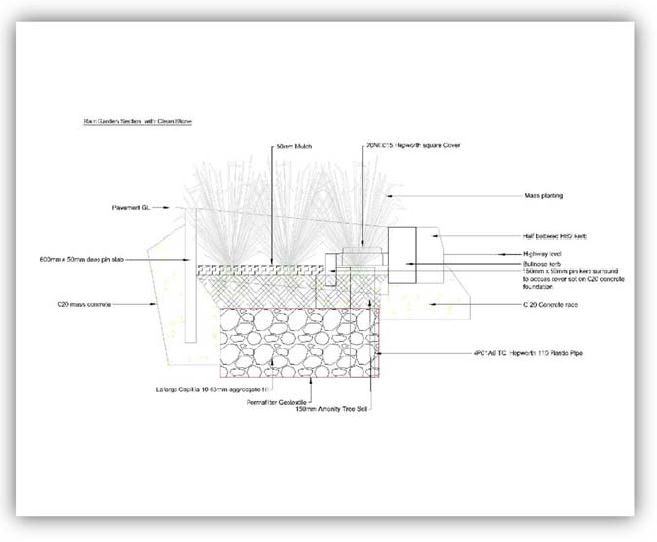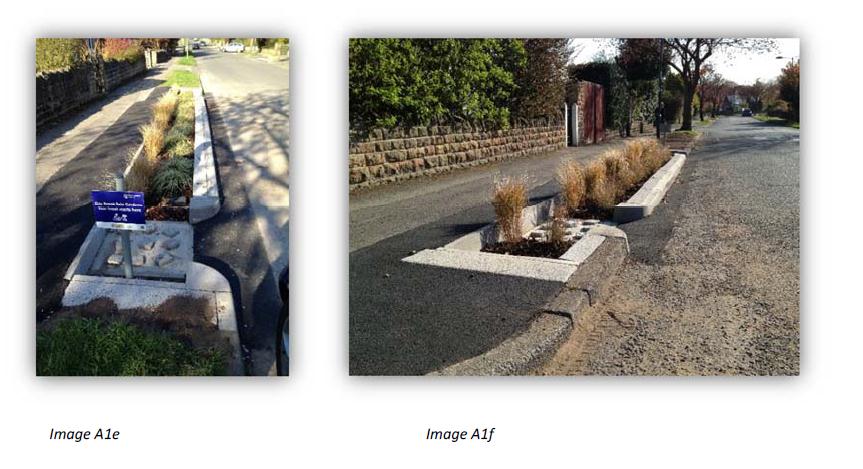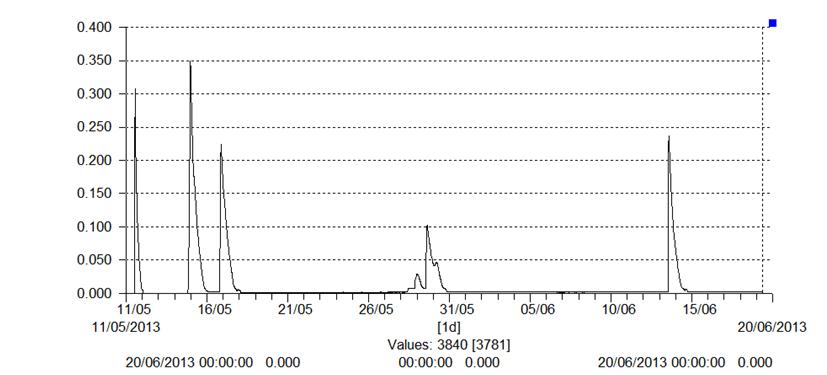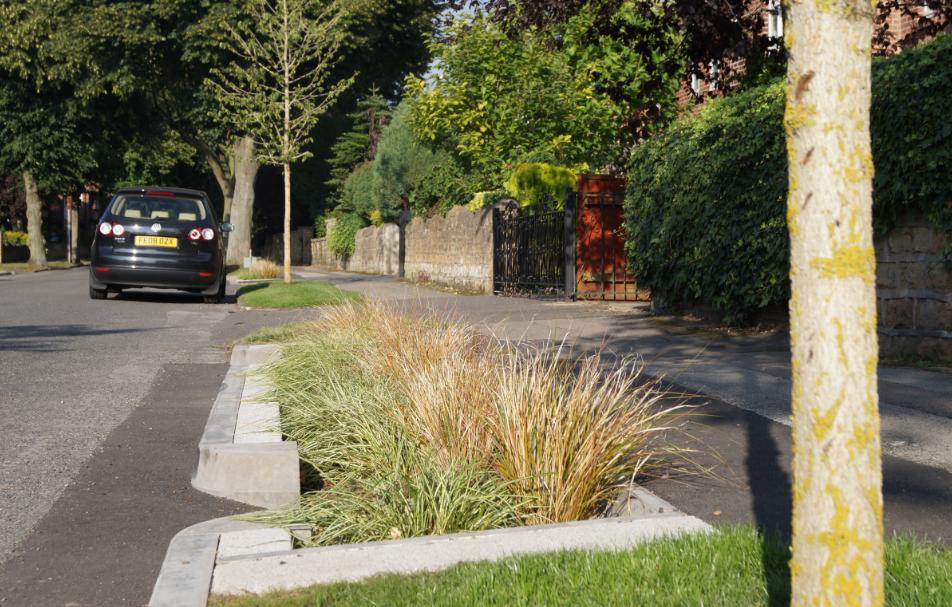Where
Location
Ribblesdale Road, Sherwood, Nottingham, NG5 3HW.
The setting is a quiet residential road, consisting of 67 properties. A grass verge with occasional mature trees runs the entire length of the road. There is limited parking pressure with most homes having provision for off-street parking.

Figure 1 a and 1 b – Existing road layout
The road is adjacent to the Day Brook. This heavily modified watercourse has poor water quality due in part to numerous sources of urban diffuse pollution. In addition there are a total of 972 properties which fall within the Day Brook floodplain. Previous fluvial events have led to property flooding downstream.

Figure 2 – Ribblesdale Road and Day Brook
Scheme Description
This pilot retrofit SuDS project was a result of collaboration between the Environment Agency, Nottingham City Council, Groundwork Greater Nottingham and Severn Trent Water. The construction phase was completed in May 2013.
The scheme was designed to achieve the following objectives;
- Document and evaluate the design and construction of a series of rain gardens within an existing highway setting.
- Maximise surface water interception, attenuation and infiltration.
- Test the effectiveness of rain gardens in managing surface water from the public highway.
- Encourage participation from local residents in the design and future management of the rain gardens.
- Evaluate the effectiveness of the scheme as an engagement tool around the sources of urban diffuse pollution and flood risk.
- Highlight the role that retrofit SuDS can play in improving the quality and reducing the volume of surface water flowing to urban watercourses.
Partners’ contributions;
Groundwork
- Developed the outline and detailed designs.
- Helped secure support for the scheme from City councillors.
- Worked with the Highway Design team to ensure the scheme would integrate and interact well with the existing highway layout.
- Managed contract negotiation and implementation of the scheme.
- Led community consultation and facilitated the residents’ liaison group.
Nottingham City Council
- Assisted with the design and technical development of the scheme.
- Safety audit of rain garden design undertaken by Traffic Safety team.
- Oversaw rain garden construction as Highway Authority.
- Ongoing maintenance of the rain gardens.
The Environment Agency
- Provided the capital funding through the Midland’s MURCI Waters programme.
- Provided technical guidance on water quality and diffuse pollution.
- Lead for ongoing evaluation.
Severn Trent Water
- Built a surface water hydraulic model of the scheme.
- Assisting with ongoing evaluation.
SuDS used and how it works
A total of 21 linear rain gardens (total of 148m2) were constructed within the grass verge, allowing for the constraints of access, below ground services, street furniture and trees. The rain gardens utilise a combination of clean stone aggregate and proprietary units to create void space beneath a planted topsoil layer. They were designed to capture runoff from 5500 m2 of highway from a total surface area of 7100 m2. The remaining surface area could not be incorporated into the scheme due to a number of mature trees clustered in one section of Ribblesdale Road.
The scheme was designed to manage surface water runoff from a 1:30 year event and to always intercept and treat the, often more polluted, first flush of highway runoff. Existing highway gullies have been retained to allow for overflow when the rain gardens reach capacity.
Proprietary water attenuation cells were a key part of the initial design as they provide significantly higher void space capacity than clean stone. However, budget constrains meant that the use of proprietary cells was reduced and replaced by stone fill in a number of gardens. It is hoped that differences in the performance of the 2 different rain garden designs will be evaluated over the coming years.


Figure 3 a and b Section Drawings of the two rain garden designs


Figure 4 a, b and c Completed rain gardens
Working with Fire Brigade the project team were able to test the inlet capacity of the rain gardens, click here to watch the video.
Plant selection
The following plants were used in three combinations with Stipia being used throughout;
Stipia arundinacea
Carex ‘evergold’
Miscanthus Yakushima Dwarf
Festuca blue fox
Plant selection for the rain gardens was influenced by the following:
- Need for tolerance of wide fluctuations in soil moisture levels from inundation to long dry periods, exacerbated by a highly permeable growing media.
- Provision of sufficient structure to assist pedestrian and driver differentiation between footpath, road and rain garden without blocking sight lines.
- Use of evergreen species to reduce leaf debris in the rain gardens and the associated maintenance.
- Aesthetics.
Semi-mature plant stock was used to ensure there was sufficient plant structure from completion of the rain gardens.
Maintenance
The existing and predicted maintenance regimes were reviewed prior to construction. It is expected that maintenance of the rain gardens will be limited to an annual trim of the vegetation, with occasional mulching and clearing of the inlet.
As the rain gardens were constructed within existing grass verges, the reduction of grass cutting will off-set the cost of the new maintenance regime.
Click here to see the maintenance analysis.
Costs
Capital costs for the project were £68K. Staff time was also provided by Nottingham City Council and the Environment Agency. Groundwork’s time for design and community engagement was paid for by the overall project budget.
The project delivered 148m2 of rain garden which equates to £460 per m2. The cost for rain gardens filled with aggregate was around £300 per m2 but was significantly more where attenuation cells were utilised.
Evaluation
The scheme has been designed to facilitate ongoing evaluation of the rain gardens.
The installation of a data logger provides continuous water depth recording within the void space beneath one rain garden. The data obtained shows how the rain garden performs during and after rainfall. Variation in rain garden performance will be monitored over time.

Figure 6 Water level within rain garden void following 5 rainfall events in June 2013
In addition, initial results from the InfoWorks CS 2D model of the scheme suggests a 33% reduction in the flow reaching the sewer during a 1 in 1 return period storm.

Figure 7 Model output showing reduced peak in sewer flow
A survey of local residents was also undertakenb. The 17 residents who responded to the survey (25% response rate) have provided a mixed picture of opinions. Some residents remain incredibly supportive of the scheme and are “absolutely delighted” with the finished rain gardens. Others dislike the rain gardens and feel that, in particular, they have taken away parking space or created a hazard for pedestrians or cyclists.

Figure 8 Results of resident survey
Benefits & achievements
- SuDS retrofit scheme delivered through partnership
- Proven surface water capture and infiltration leading to reduced pressure on downstream sewer and watercourse.
- Increased understanding and awareness of the benefits of retrofit SuDS at a community and partner level.
Challenges and lessons learned
The following challenges were managed during the project;
- Limited time to design and construct the scheme.
- Varying support for the scheme amongst residents and general lack of understanding of how surface water contributes to flooding and poor water quality.
- Safety concerns – residents and safety audit helped refine rain garden design.
The future
Evaluation of the project will continue over the next twelve months.
The partners will work to promote the multiple benefits of retrofit rain gardens and use the results of the pilot to influence future surface water and fluvial flood defence schemes.
Team and details
Project Lead and Designer: Paul Crawford, Landscape Architect, Groundwork Greater Nottingham
Funding and Diffuse Pollution: John Brewington, Programme Manager, Environment Agency
Highways Design and Drainage: Chris Capewell, Team Leader, Highway Design, Bridges & Drainage, Nottingham City Council
Highways Design & Contract Engineer: Frank Knapp, Highways Design Engineer, Nottingham City Council
Contractor: Direct Labour Organisation (DLO), Nottingham City Council
Status: Constructed, May 2013
Version: November 2013




